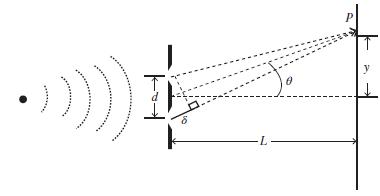Refer to the introduction to Problem 2.8. Assume the incident light is monochromatic with a wavelength (lambda=500
Question:
Refer to the introduction to Problem 2.8. Assume the incident light is monochromatic with a wavelength \(\lambda=500 \mathrm{~nm}\) and slit separation. Suppose \(d=0.100 \mathrm{~mm}\). The Young's experimental geometry is shown in the following figure:
Assume \(L=1 \mathrm{~m}\).
(a) What is the phase difference \(\varphi\) between the two waves arriving at a point \(P\) on the screen when \(\theta=0.80^{\circ}\) ?
(b) What is the phase difference between the two waves arriving at a point \(P\) on the screen when \(y=4.00 \mathrm{~mm}\) ?
(c) If \(\varphi=\frac{1}{3} \mathrm{rad}\), what is the value of \(\theta\) ?
(d) If the path difference is \(\frac{\lambda}{4}\), what is the value of \(\theta\) ?
Problem 2.8
In Young's double-slit experiment, light intensity is a maximum when the two waves interfere constructively. This occurs when
![]()
where \(d\) is the separations of the slits, \(\lambda\) the wavelength of light, \(m\) the order of the maximum, and \(\theta\) the scatter angle that the maxima occurs. Assume \(d=0.320 \mathrm{~mm}\). If a beam of \(\lambda=500 \mathrm{~nm}\) light strikes the two slits, how many maxima will there be in the angular range \(45^{\circ} \leq \theta \leq 45^{\circ}\) ?
Step by Step Answer:

Free Space Optical Systems Engineering Design And Analysis
ISBN: 9781119279020
1st Edition
Authors: Larry B. Stotts





